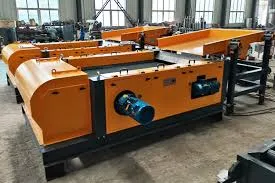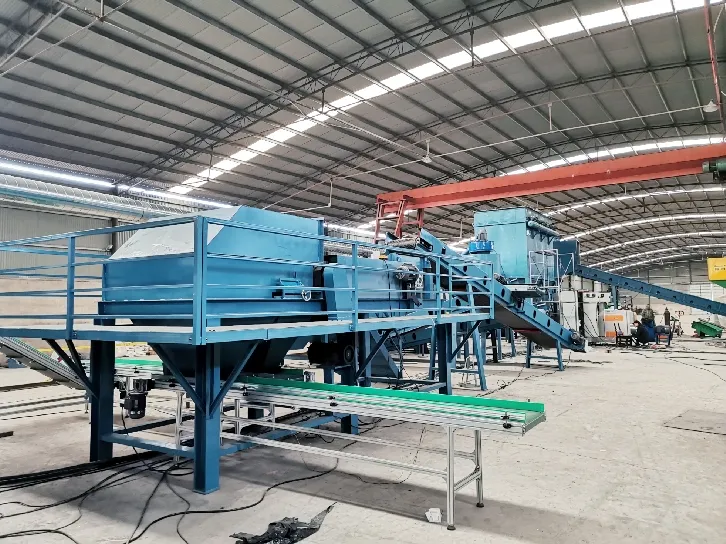Eddy current separators (ECS) are a staple in the recycling industry, notorious for their ability to effectively separate non-ferrous metals from waste streams. Ingeniously leveraging the principles of electromagnetism, these machines are essential in ensuring resources are recovered efficiently. To comprehend how ECS machines operate and why they are indispensable in modern recycling operations, it's crucial to delve into their mechanics, applications, and the refining nuances that can enhance their effectiveness.

The fundamental operation of an eddy current separator hinges on the use of alternating magnetic fields. As a non-ferrous metal, such as aluminum, approaches the ECS, its magnetic field induces swirling electric currents, known as eddy currents, within the metal. These currents generate their own magnetic fields, which oppose the primary field generated by the separator. This opposition results in a repulsive force that shoots the non-ferrous metal away from the conveyor, thereby achieving separation.
The precision of this operation underscores the ECS's reputation as an indispensable tool in processing complex waste streams. Beyond mere theory, the real-world application of ECS technology requires expertise in configuring equipment for optimal performance. Operators must fine-tune variables such as rotor speed and magnetic strength to align with specific material attributes, ensuring maximum metal recovery without compromising material quality.

To optimize performance, one must understand the design intricacies of ECS systems. Most ECS machines are comprised of a fast-spinning magnetic rotor encased in a non-conductive drum shell. The rotor's speed is a critical factor; typically, higher speeds enhance separation efficiency but can increase wear and operational costs. Adjustments to rotor speed should be meticulously calibrated based on the type and volume of material being processed.
The design of the conveyor system is equally vital. ECS units are often integrated into conveyor belts, where material is initially subjected to a drum magnet. This primary step removes ferrous metals, which could otherwise interfere with the eddy current process. Upon being cleared of ferrous content, the remaining material passes over the ECS rotor, where non-ferrous metals are ejected from the waste stream.
The accuracy and reliability of ECS devices are pivotal in maintaining their role as trusted components in recycling systems. Their ability to consistently deliver clean, metal-free end products translates to enhanced profitability for recycling companies, as well as reduced environmental impact. The credibility of ECS technology is reinforced by industry standards and third-party certifications that attest to their performance and efficiency.
eddy current separator diagram
The expertise necessary for effectively deploying ECS technology extends beyond operational aspects to encompass maintenance and troubleshooting. Regular inspection of components such as bearings, shafts, and electronic controls is crucial to prevent downtime and maintain efficiency. Replacement or recalibration of parts should be performed according to manufacturer guidelines to sustain optimal separator function.
Trust in ECS technology is further bolstered by the positive environmental outcomes enabled by their deployment. Recycling facilities utilizing eddy current separators contribute significantly to reducing landfill waste and conserving natural resources. By recovering non-ferrous metals that can be reintroduced into production cycles, ECS technology supports sustainable industrial practices and fosters a circular economy.
Authoritativeness in the field is exemplified by manufacturers and experts who continuously research and innovate ECS designs. Advancements tend to focus on increasing separation efficiency, reducing energy consumption, and enhancing the durability of the machines. Cutting-edge developments in ECS technology are propelled by a combination of academic research, field trials, and feedback from industry practitioners.
Experience plays a pivotal role in refining the implementation of ECS systems. Seasoned operators understand that variables such as particle size distribution, moisture content, and bulk density significantly influence separation outcomes. Their hands-on experience enables them to make informed adjustments, thus maximizing the efficiency and efficacy of the separation process.
In conclusion, eddy current separators are not just mechanical devices but integral components in the sustainable management of resources. Their effectiveness is rooted in the deep technical understanding and operational expertise of the professionals who design, operate, and maintain them. Through ongoing innovation and refinement, ECS technology continues to embody the ideals of experience, expertise, authoritativeness, and trustworthiness within the recycling industry.


